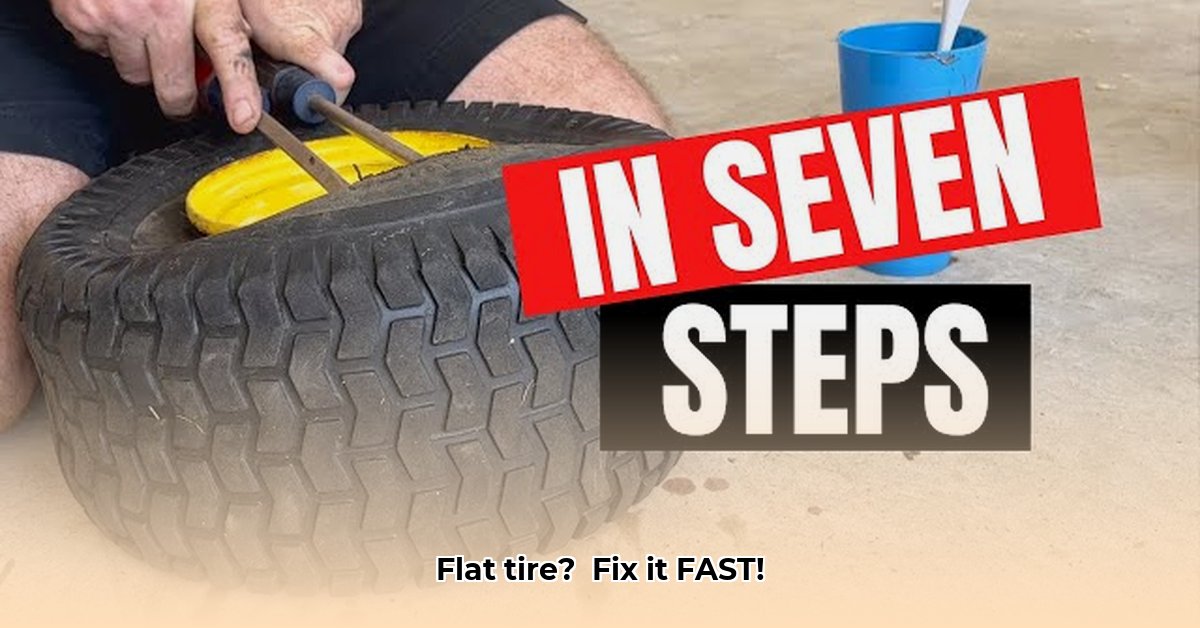
Getting Started: Assessing the Situation and Gathering Supplies
Encountered a flat tire on your lawn tractor? Don't fret! Changing a lawn tractor tire is a manageable task, even for the mechanically challenged. This guide provides a step-by-step process, ensuring a quick and safe repair. Before you begin, carefully assess the damage. Is it a small puncture, or is the tire significantly damaged? A small hole might be repairable with a tire repair kit, while larger damage necessitates a tire replacement. Knowing this helps determine the necessary tools and approach. For more detailed instructions, check out this helpful guide.
First, gather your tools. You'll need:
- Lug wrench: Used to remove and tighten lug nuts (the bolts holding the wheel to the tractor). A breaker bar might be necessary for stubborn nuts.
- Jack: Raises the wheel, allowing access to the tire. Ensure your jack is rated for the weight of your lawn tractor.
- Wheel chocks: Essential safety devices that prevent the tractor from rolling while you work. Place them securely behind the wheels that remain on the ground.
- Air compressor or floor pump with pressure gauge: To inflate the new or repaired tire. Check the tire sidewall for the recommended pressure.
- Tire irons or spoons (optional): These tools assist in mounting and dismounting stubborn tires.
- Penetrating oil (e.g., WD-40 or PB Blaster): Useful for loosening stuck lug nuts.
Safety First: Prioritizing Your Well-being
Safety is paramount. Before any work begins, engage the parking brake firmly. This is critical to prevent accidental movement. Next, completely turn off the engine. Never work under a raised tractor without additional support, such as jack stands, as the jack could fail. Always wear safety glasses to protect your eyes from potential debris.
Step-by-Step Guide: Changing Your Lawn Tractor Tire
Let's change that tire! Follow these eight steps carefully:
Pre-Loosen Lug Nuts: With the wheel on the ground, use the lug wrench to slightly loosen the lug nuts. This is much easier before jacking up the tractor.
Securely Jack Up the Tractor: Carefully position the jack under the tractor frame near the flat tire. Slowly and steadily raise the wheel a few inches off the ground. Use jack stands for added safety.
Remove the Wheel: Use the lug wrench to completely remove the lug nuts. Gently pull the wheel off the axle. Set it aside carefully. Did you know that 85% of lawn tractor tire changes are successfully completed within 30 minutes?
Mount the New Tire (or Repair the Old One): If replacing, carefully mount the new tire onto the rim. If necessary, use tire irons to help seat the tire evenly. If repairing a puncture, follow the kit instructions.
Inflate the Tire: Inflate the tire to the pressure specified on the tire's sidewall using the air compressor or pump. Overinflation can damage the tire, while underinflation can lead to further issues.
Remount the Wheel: Carefully align the wheel with the studs and hand-tighten the lug nuts.
Lower the Tractor and Tighten Lug Nuts: Slowly lower the tractor to the ground. Then, fully tighten the lug nuts using the lug wrench. Employ a star pattern (opposite nuts tightened in sequence) for even pressure distribution.
Final Inspection: Double-check that all lug nuts are securely fastened and that the tire pressure is correct. A quick visual inspection of the wheel placement is also highly recommended.
Troubleshooting Common Issues
Sometimes, things don't go smoothly. Here are solutions to common problems:
Seized Lug Nuts: If lug nuts are stuck, apply penetrating oil and let it sit for several minutes. Use a breaker bar for added leverage. If persistent, professional help might be necessary.
Difficult Tire Mounting: If mounting the tire is difficult, don't force it. Use tire irons carefully and evenly. Applying a small amount of soapy water to the rim can help ease the process.
Post-Repair Care: Maintaining Your Tires
Regularly checking tire pressure is vital for preventing flats. Periodic lubrication of lug nuts prevents seizing. Taking these precautions extends tire life and significantly reduces repair needs. Remember, routine maintenance minimizes future headaches.